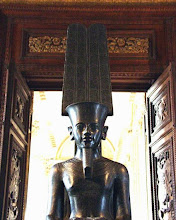Nefertiti II
 See also this post
See also this post
"The facial trauma found on a certain mummy known as the "young lady", one of three discovered in the tomb of Amenhotep II (KV35) in the Valley of the Kings, was used by Joann Fletcher as the main evidence for the damage being caused by malice and perpetrated post-mortem, in revenge against Queen Nefertiti. This conclusion does not make any sense, because anyone who wanted to take revenge on the mummy of Nefertiti could damage the entire mummy rather than make this small cut on the face. However, there is new evidence from the CT scan performed on the mummy to suggest that the trauma to the left cheek of the young lady's face was almost certainly done post-mortem, occurring before the embalming process.
The evidence cited for the post-mortem trauma was: first that the bone, skin, and muscle fragments were pushed inwards, down into the wound and not outwards (as would happen if the mask had been ripped off the face). Ashraf Selim, professor of radiology in the Faculty of Medicine at Cairo University, says it would be impossible to push the dry, embalmed tissues down and have them maintain their integrity without being broken off, suggesting that this happened before the body was embalmed. Second, the wound was cleaned and there were no loose bone or flesh fragments within the cavity, as one would expect if the wound occurred after embalming. Third, there were bony fragments deep within the nasal cavity beneath the layer of resin, implying that the fracture had happened before embalming. Fourth, the violence of the wound made it seem unlikely that it was committed by the embalmers. Paul Gustorer, another radiologist, suggested that this trauma was very similar to a wound that he had seen on a patient who had been kicked in the face by a horse.
Victor Loret, who discovered the mummies in the tomb of Amenhotep II (KV35) in 1898, also found a wig in the tomb lying near the mummies. Fletcher located this wig in the Egyptian Museum in Cairo. It is in the Nubian style which, according to Fletcher, was worn by Nefertiti. However, there is no evidence to connect the wig with the "young lady" just because it was found in the same tomb. It is also important to remember that Nefertiti was not the only royal woman of Amarna to wear the Nubian wig. There is also evidence that Kiya, the mother of Tutankhamun, wore the wig.
Concerning the double piercing on the left ear of the young lady, Fletcher stated that this double piercing occurred only in depictions of Nefertiti and one of her daughters, and not on other females. The mummy does indeed have a double piercing in her left ear. However, she is not the only known mummy to have a double piercing. For example, it also occurs on the mummy of Thuya, mother of Queen Tiye.
Fletcher also stated that the finds associated with the embalming of the mummy showed evidence that the mummy dated to the 18th Dynasty. The presence of what appeared to be nefer beads was noticed on the X-ray; these were used on necklaces in a later part of the 18th Dynasty. In the report on the mummy, we also noted that the mummification style was very different from that of King Tut.
Concerning Fletcher's main point, that she has found the missing right arm and that this arm was flexed in the royal position of a king, the CT scan showed that both arms were actually extended beside the body and that the right arm had two breaks, one in the upper arm and one at the wrist. The flexed right arm was completely separated from the body, and Selim said that it definitely did not belong to that mummy.
The CT scan confirmed that the mummy known as the "young lady" was a female and not a male as previously suggested. Fletcher also concluded that the young lady was 30 years old. The CT scan concluded that the mummy was actually between 25 and 35 years of age. The last two points of evidence are similar, but all the other evidence suggests that this mummy cannot be Queen Nefertiti. In this respect, we must close this subject and begin to make further studies to identify our "young lady"."
Source






